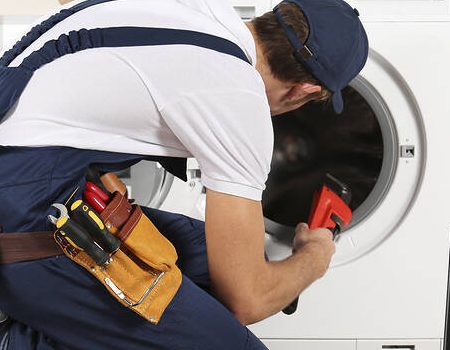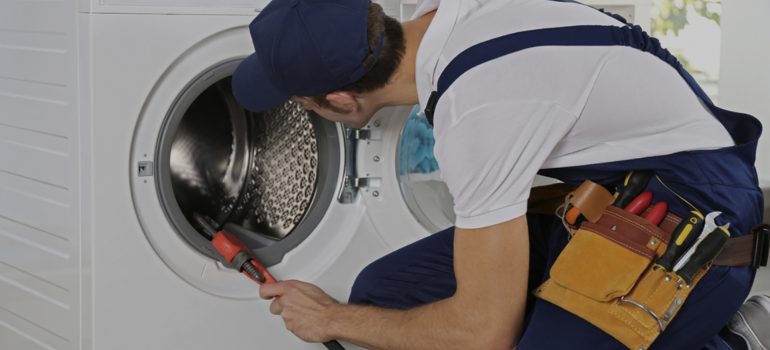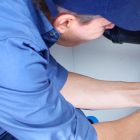How to Fix a Noisy Washing Machine
Is your washing machine making more noise than usual? A noisy washing machine can be a real nuisance, disrupting the peace of your home and signaling that something might be wrong. Whether it’s rattling, banging, or vibrating excessively, a noisy washing machine isn’t just annoying—it could be a sign that you need to address an issue before it becomes a costly repair. In this blog, we’ll dive into the common causes of washing machine noise, how to diagnose the problem, and practical steps to fix it. Let’s ensure your laundry routine returns to being a quiet, peaceful task.
Understanding the Causes of a Noisy Washing Machine
Before diving into solutions, it’s important to understand the potential causes of a noisy washing machine. Identifying the root cause is crucial to fixing the issue effectively.
Unbalanced Load
One of the most common reasons for a noisy washing machine is an unbalanced load. When clothes are not evenly distributed in the drum, it can cause the machine to become off-balance during the spin cycle. This imbalance leads to banging and thumping sounds, which can be alarming but are usually easy to fix.
Worn Out Bearings
Bearings support the drum of the washing machine and help it spin smoothly. Over time, these bearings can wear out, leading to a grinding or whining noise. This issue requires prompt attention, as neglected bearings can damage other components of the machine.
Loose or Damaged Drum
If the drum is loose or damaged, it can create a loud noise when spinning. The drum might be knocking against other parts of the machine, leading to a noticeable sound during operation. This issue often requires a professional inspection to determine if repair or replacement is necessary.
Faulty Motor
The motor is the heart of the washing machine. If the motor is faulty, it can produce strange noises. A buzzing or humming sound might indicate a problem with the motor or its components, and it could mean that some parts are worn out or need to be replaced.
Clogged or Faulty Pump
The pump in a washing machine drains the water during the wash cycle. If it becomes clogged with debris or is malfunctioning, it can lead to loud noises. A faulty pump might produce a gurgling or grinding noise, indicating that it needs cleaning or replacement.
Loose Parts or Fasteners
Sometimes, a noisy washing machine is simply the result of loose parts or fasteners. Over time, vibration and movement can cause screws and other components to loosen. Tightening these parts can often resolve the noise issue.
Understanding these common causes of a noisy washing machine will help you diagnose and fix the problem more efficiently. Keep these potential issues in mind as we explore how to address them in the following sections.
Diagnosing Your Noisy Washing Machine
Once you’ve understood the potential causes, the next step is diagnosing the specific issue your washing machine is facing. Here’s how to get started with identifying what’s making your washing machine so noisy.
Listen Closely
The first step in diagnosing a noisy washing machine is to listen carefully. Different noises can indicate different problems. For instance, a banging noise may suggest an unbalanced load, while a grinding noise might point to worn-out bearings. By identifying the type of noise, you can narrow down the possible causes.
Check for Balance
To determine if an unbalanced load is causing the noise, stop the machine and redistribute the clothes evenly in the drum. Make sure that heavier items are spread out and not clumped together. Restart the machine and see if the noise persists. If the noise stops, an unbalanced load was likely the culprit.
Inspect the Drum
Open the washing machine and inspect the drum for any visible signs of damage or looseness. Try to move the drum manually. If it feels loose or wobbles significantly, the bearings or the drum itself might be worn out. This issue usually requires professional repair.
Examine the Motor and Pump
To check the motor and pump, unplug the washing machine and remove the back panel to access these components. Look for any visible signs of damage or wear. If you suspect an issue with the motor or pump, it might be best to contact a professional, as these parts can be complex and dangerous to handle without proper expertise.
Tighten Loose Parts
Inspect the washing machine for any loose parts or fasteners. Use a screwdriver or wrench to tighten any screws or bolts that might have come loose over time. Pay special attention to the feet of the washing machine, as they play a crucial role in stabilizing the machine during operation.
Call for Professional Help
If you’ve tried diagnosing the issue but still can’t identify the problem, or if the solution seems beyond your skill level, it might be time to call a professional. A trained technician can provide a thorough inspection and offer solutions that ensure the longevity and efficiency of your washing machine.
By following these diagnostic steps, you can identify the cause of your noisy washing machine and take appropriate action. Now, let’s move on to the solutions that can help you fix these common issues.
Solutions for a Noisy Washing Machine
After diagnosing the issue, it’s time to roll up your sleeves and tackle the problem. Here are some practical solutions for fixing a noisy washing machine.
Fixing an Unbalanced Load
If an unbalanced load is causing the noise, here’s how to fix it:
- Stop the Machine: As soon as you hear the noise, stop the washing machine to prevent further imbalance.
- Redistribute Clothes: Open the drum and redistribute the clothes evenly. Separate heavy items and spread them out across the drum.
- Adjust the Load Size: Avoid overloading the machine. Follow the manufacturer’s guidelines for load size and avoid cramming too many clothes in at once.
- Use a Laundry Ball: Consider using a laundry ball or wash booster to help keep clothes separated and balanced during the wash cycle.
Replacing Worn Out Bearings
If worn-out bearings are causing the noise, replacement might be necessary. This task is best left to a professional due to the complexity and risk involved. Here’s what the process typically involves:
- Remove the Drum: The drum needs to be taken out to access the bearings. This requires dismantling parts of the washing machine.
- Replace the Bearings: The old bearings are removed and replaced with new ones. It’s crucial to ensure the new bearings are compatible with your washing machine model.
- Reassemble the Machine: Once the new bearings are in place, reassemble the washing machine and test it to ensure the noise is gone.
Repairing or Replacing the Drum
If the drum is loose or damaged, it may need repair or replacement. Here’s what to do:
- Inspect the Drum: Check for visible damage or loose connections.
- Tighten Connections: If the drum is loose, tighten any screws or fasteners holding it in place.
- Contact a Professional: If the drum is damaged, contact a professional for repair or replacement. This task requires specialized tools and expertise.
Addressing a Faulty Motor
A faulty motor can produce a variety of noises, indicating the need for inspection and potential replacement:
- Check for Obstructions: Ensure no debris or clothing items are caught in the motor.
- Inspect the Motor: Look for signs of wear or damage. If you suspect a problem, call a professional technician for assessment and repair.
- Consider Replacement: If the motor is beyond repair, replacement might be necessary to restore the washing machine’s functionality.
Cleaning or Replacing the Pump
If the pump is causing noise, cleaning or replacing it can help:
- Clean the Pump: Unplug the machine and access the pump. Remove any debris or blockages that might be causing noise.
- Inspect the Pump: Check for signs of wear or damage.
- Replace if Necessary: If the pump is malfunctioning, replace it with a new one that matches your washing machine’s specifications.
Tightening Loose Parts
Loose parts can often be fixed with a simple tightening:
- Inspect the Machine: Look for loose screws, bolts, or fasteners.
- Tighten the Parts: Use a screwdriver or wrench to secure loose parts.
- Stabilize the Feet: Ensure the washing machine’s feet are level and stable to prevent excessive vibration.
By following these solutions, you can effectively address the common causes of a noisy washing machine and restore peace to your laundry routine. However, if you’re unsure or uncomfortable performing any of these tasks, don’t hesitate to seek professional assistance.
Preventing Future Noise Issues
Prevention is key to keeping your washing machine running smoothly and quietly. Here are some tips to help you prevent future noise issues and maintain your washing machine’s performance.
Regular Maintenance
Performing regular maintenance on your washing machine can go a long way in preventing noise problems:
- Clean the Machine: Regularly clean the drum, filters, and detergent drawer to prevent buildup of dirt and debris.
- Inspect Parts: Periodically inspect parts like the motor, pump, and bearings for signs of wear and tear.
- Tighten Fasteners: Check and tighten any loose screws or bolts to ensure the machine remains stable during operation.
Proper Loading Techniques
Adopting proper loading techniques can help prevent imbalance and noise issues:
- Follow Load Guidelines: Adhere to the manufacturer’s guidelines for load size and distribution.
- Balance the Load: Distribute clothes evenly in the drum to prevent imbalance during the spin cycle.
- Use a Load Sensor: If your washing machine has a load sensor, use it to ensure optimal load size and balance.
Avoiding Overloading
Overloading your washing machine can strain its components and lead to noise problems:
- Respect Capacity Limits: Be mindful of the washing machine’s capacity limits and avoid overloading it with too many clothes.
- Wash Large Items Separately: Wash bulky items like blankets and towels separately to prevent imbalance.
- Spread Out Heavy Items: Ensure heavy items are evenly distributed in the drum to prevent imbalance during the spin cycle.
Monitoring for Early Signs
Being vigilant and proactive can help you catch potential issues before they become major problems:
- Listen for Unusual Noises: Pay attention to any unusual noises coming from your washing machine and address them promptly.
- Watch for Vibrations: Monitor for excessive vibrations during the spin cycle, as this can indicate an imbalance or other issue.
- Schedule Regular Inspections: Consider scheduling regular inspections with a professional technician to catch potential issues early.
By following these preventive measures, you can extend the life of your washing machine and reduce the likelihood of noise issues. Remember, regular maintenance and proper care are essential for keeping your appliance running smoothly.
When to Call a Professional
While many noise issues can be resolved with DIY solutions, some problems may require professional assistance. Here’s when to consider calling a professional for help:
Complex Repairs
If the issue involves complex repairs, such as replacing bearings or the motor, it’s best to call a professional. These tasks require specialized tools and expertise to ensure proper installation and functionality.
Persistent Noise
If you’ve tried DIY solutions but the noise persists, it’s time to seek professional help. A trained technician can accurately diagnose the problem and provide effective solutions.
Warranty Considerations
If your washing machine is still under warranty, avoid attempting repairs yourself. DIY repairs can void the warranty and lead to additional costs. Instead, contact the manufacturer or an authorized service provider for assistance.
Safety Concerns
If you’re unsure or uncomfortable with any repair process, prioritize safety and call a professional. Attempting complex repairs without proper knowledge can result in injury or further damage to the machine.
Contacting a Professional
If you need professional assistance with your noisy washing machine, don’t hesitate to reach out for help. Contact us at 0508700774 to schedule a service appointment with one of our experienced technicians. We’re here to help you get your washing machine back to its quiet and efficient operation.
By knowing when to call a professional, you can ensure your washing machine receives the proper care and attention it needs, preventing further damage and ensuring its longevity.
Conclusion
A noisy washing machine can be more than just an annoyance; it can be a sign of underlying issues that need attention. By understanding the common causes of washing machine noise, diagnosing the problem, and implementing effective solutions, you can restore peace to your laundry routine. Remember to perform regular maintenance, adopt proper loading techniques, and seek professional help when necessary. With these tips, you can keep your washing machine running smoothly and quietly for years to come. If you have any questions or need professional assistance, feel free to contact us at 0508700774. We’re here to help you enjoy a quieter, more efficient laundry experience.







Recent Comments